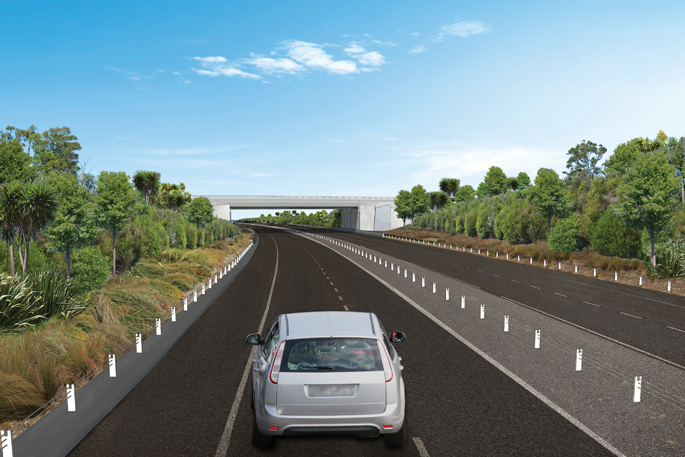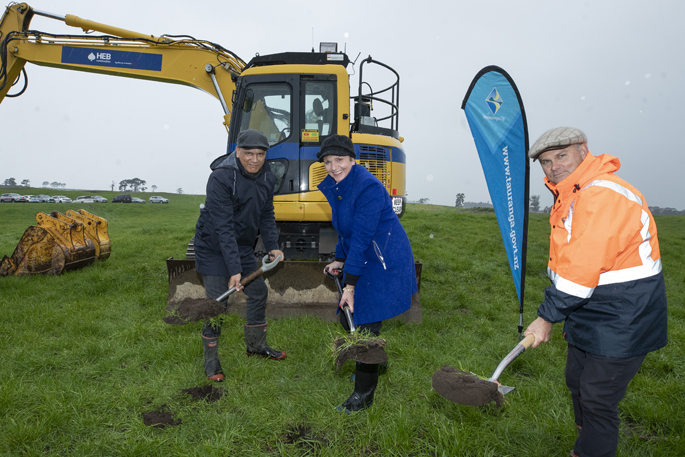A karakia has been performed and the sod turned on a $90 million roading project that will provide better access to Pāpāmoa East.
The Pāpāmoa East Interchange will be constructed over the Tauranga Eastern Link east of the Wairakei neighbourhood, linking Te Okuroa Drive to State Highway 2.
It will also provide a connection to the Rangiuru Business Park once that is operational.
At the sod turning ceremony, Bay of Plenty Regional Transport Committee chair Lyall Thurston said the interchange is significant because, once complete, Pāpāmoa East residents will no longer need to access State Highway 2 via Domain Road.
'From Pāpāmoa East to Rotorua you could be looking at a 35 minute journey, opening up new commuting opportunities,” says Thurston.
'The interchange is a full-diamond interchange that will provide a direction connection between Pāpāmoa East and the Tauranga Eastern Link, unlocking access to the Wairakei and Te Tumu commercial and residential growth areas in Pāpāmoa.”
He says Pāpāmoa is one of the country's fastest growing residential areas.
'Once developed Pāpāmoa East will be a city the size of Nelson with 40,000 people.
'The interchange is fundamental to the success of a couple of big projects in the area, namely the planned town centre at Wairakei and the Rangiuru Business Park.
'It's a great day for connectivity in the Bay of Plenty,” says Thurston.
 Rain didn't dampen the spirits of those gathered to mark the start of construction of the Pāpāmoa East Interchange. Photo: John Borren/SunLive.
Rain didn't dampen the spirits of those gathered to mark the start of construction of the Pāpāmoa East Interchange. Photo: John Borren/SunLive.
Representatives and staff from Tauranga City Council, Western Bay of Plenty District Council, Bay of Plenty Regional Council Waka Kotahi NZ Transport agency, kaumatua from Te Kapu o Waitaha, Tapuika Iwi Authority, Ngā Pōtiki a Tamapohore Trust and Ngāti Whakaue ki Maketū braved the rain for the sod turning on today.
Tauranga City Council commission chair Anne Tolley joked that she was unsure if the rain was 'heaven crying with frustration of how long it's taken to get here or crying with joy”.
She says the interchange has been planned for around 20 years and it was 'self-evident” connection is needed from Pāpāmoa East to allow future development.
'This is a much anticipated project that will allow more housing to be built for a growing city,” says Tolley.
'Tauranga's coastal fringe is expected to grow significantly over the next 40 years, reaching up to 30,000 people by 2060. We need more dwellings to be built to keep up with that growth.
'This interchange will provide increased capacity and connectivity to support the traffic demands associated with the development of Pāpāmoa East.”
Tauranga City Council general manager infrastructure Nic Johansson emphasises what the interchange will mean for the existing community in Pāpāmoa East.
'This critical piece of infrastructure will change the dynamic for residents in the area,” says Johansson.
'It's our objective to connect people to the places they live, learn, work and play at less than 45 minutes travel time.”
The first stage of construction will start mid-July and be completed in April 2023.
This incorporates earthworks to construct the southern ramps on the Tauranga Eastern Link.
 An artist's impression of the Pāpāmoa East Interchange. Photo: Supplied.
An artist's impression of the Pāpāmoa East Interchange. Photo: Supplied.
Stage one of construction includes, a nine metre high embankment – forming the westbound (Tauranga) exit and entry ramps of the interchange.
As well as installing three culverts, including one under the Tauranga Eastern Link, installing flexible safety barriers and widening the southern side of Tauranga Eastern Link, and earthworks to build a stormwater retention pond, swales and connecting drains.
Construction of the remainder of the interchange is scheduled to start mid-2023 and be ready for use in early 2026.
Future stages of this project will see construction of an extension of Te Okuroa Drive, the interchange itself and the connection between Sands Avenue and Te Okuroa Drive.
Funding for stage one is through the Housing Infrastructure Fund, which is currently going through final sign off.
Public Interest Journalism funded through NZ On Air.




0 comments
Leave a Comment
You must be logged in to make a comment.